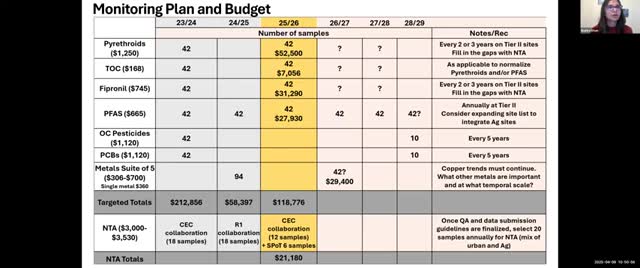Research team evaluates wastewater effects on fipronil levels in California watersheds
April 26, 2025 | California Water Quality Monitoring Council, Boards and Commissions, Executive, California
This article was created by AI summarizing key points discussed. AI makes mistakes, so for full details and context, please refer to the video of the full meeting. Please report any errors so we can fix them. Report an error »

During the recent California Water Quality Monitoring Council meeting on April 26, 2025, discussions centered on the rising costs of water quality analyses and the implications for monitoring programs. The meeting highlighted the need for updated pricing structures for various analytes, with significant increases noted for metals and organic compounds. For instance, the cost for a suite of five metals has jumped from $3.00 to $700, reflecting broader trends of increasing expenses in environmental monitoring.
Key discussions also focused on the number of sites planned for analysis, with 42 sites identified for current and future assessments. Participants emphasized the importance of determining which specific sites should be included in this monitoring effort, particularly in relation to the frequency and spatial scale of analyses. This is crucial for ensuring that the data collected is representative and useful for addressing water quality issues.
A significant portion of the meeting was dedicated to exploring potential sources of contamination, particularly concerning the pesticide fipronil. One participant raised concerns about wastewater contributions to upstream sites, linking pet treatments to increased concentrations of harmful chemicals in surface water. This connection underscores the need for a more comprehensive understanding of how urban runoff and sewage treatment plants may influence water quality.
While some historical data on sewage treatment plant inputs have been collected, participants acknowledged that a systematic analysis has not been conducted recently. This gap in data could hinder efforts to fully understand the impact of these sources on water quality, particularly in urban areas where land use patterns might not align with expected contamination levels.
As the meeting concluded, participants recognized the need for further investigation into these issues, particularly as new data on fipronil becomes available. The discussions highlighted the ongoing challenges faced by water quality monitoring programs and the importance of adapting strategies to address emerging concerns effectively. The outcomes of this meeting will play a crucial role in shaping future monitoring efforts and ensuring the safety of California's water resources for its residents.
Key discussions also focused on the number of sites planned for analysis, with 42 sites identified for current and future assessments. Participants emphasized the importance of determining which specific sites should be included in this monitoring effort, particularly in relation to the frequency and spatial scale of analyses. This is crucial for ensuring that the data collected is representative and useful for addressing water quality issues.
A significant portion of the meeting was dedicated to exploring potential sources of contamination, particularly concerning the pesticide fipronil. One participant raised concerns about wastewater contributions to upstream sites, linking pet treatments to increased concentrations of harmful chemicals in surface water. This connection underscores the need for a more comprehensive understanding of how urban runoff and sewage treatment plants may influence water quality.
While some historical data on sewage treatment plant inputs have been collected, participants acknowledged that a systematic analysis has not been conducted recently. This gap in data could hinder efforts to fully understand the impact of these sources on water quality, particularly in urban areas where land use patterns might not align with expected contamination levels.
As the meeting concluded, participants recognized the need for further investigation into these issues, particularly as new data on fipronil becomes available. The discussions highlighted the ongoing challenges faced by water quality monitoring programs and the importance of adapting strategies to address emerging concerns effectively. The outcomes of this meeting will play a crucial role in shaping future monitoring efforts and ensuring the safety of California's water resources for its residents.
View full meeting
This article is based on a recent meeting—watch the full video and explore the complete transcript for deeper insights into the discussion.
View full meeting
